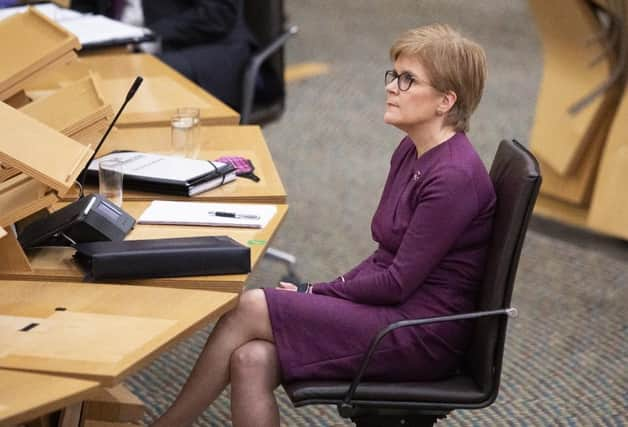Nicola Sturgeon's lockdown levels announcement speech in full


Presiding Officer
I will shortly confirm the different levels of protection to be applied across Scotland from Monday, and explain some of the reasoning behind these decisions.
However, a detailed analysis paper is also being published which sets out our assessment of each of the five factors and our overall judgment, for each local authority.
Advertisement
Hide AdAdvertisement
Hide AdFirstly, though, I will give an update on today’s Covid statistics.
The total number of positive cases reported yesterday was 1,128.
This represents 7.1 per cent of people newly tested, and takes the total number of cases to 61,531.
416 of the new cases were in Greater Glasgow and Clyde, 266 in Lanarkshire, 121 in Ayrshire and Arran and 117 in Lothian.
The remaining cases were spread across nine other health board areas. Only Shetland has no new cases today.
I can also confirm that 1,152 people are in hospital – that is an increase of 35 from yesterday.
86 people are in intensive care, which is one more than yesterday.
And I deeply regret to say that in the last 24 hours, a further 37 deaths have been registered of patients who first tested positive over the previous 28 days.
Advertisement
Hide AdAdvertisement
Hide AdThat means that the total number of deaths, under the measure used in our daily figures, is now 2,791.
Once again, I want to send my deepest condolences to all those who have lost a loved one to this virus.
These figures show that we are still seeing high numbers of new cases, increasing hospital and ICU admissions and, sadly, a rising number of deaths.
Those issues are not unique to Scotland. We have seen a resurgence in the virus in all parts of the UK, across Europe, and right around the world.
Last night, for example, both France and Germany reimposed nationwide lockdowns.
In Scotland, we acted early - with some difficult but necessary measures - and we hope that this will have the effect of slowing the spread and preventing a further deterioration in our position.
And while we cannot be certain - and have no grounds for complacency - we do see some encouraging signs that this might be the case.
Last week I indicated that we were beginning to see a significant slowing in the rate at which new cases are increasing. I can confirm today that this has continued.
Advertisement
Hide AdAdvertisement
Hide AdCases in the last week, up to today, have increased by four per cent. Two weeks ago the weekly increase was 40 per cent.
And our latest estimate of the R number, published today, suggests that it is still above one, but may have fallen slightly to 1.3.
All of this suggests that the measures introduced five weeks ago to curb household meetings are having an effect.
And the additional measures introduced three weeks ago - to significantly restrict hospitality - may also be starting to have an impact.
All of that is down to the sacrifices of people the length and breadth of the country.
However, we must be under no illusions. Europe is now firmly in the grip of a second wave of Covid.
Cases here are still rising, albeit the rate of growth appears to be slowing.
And the virus is still highly infectious. It will take every opportunity to spread.
Advertisement
Hide AdAdvertisement
Hide AdSo unless we act individually and collectively to protect and build on the progress we see today, it will quickly go into reverse.
Our strategic framework aims to tackle the virus with measures strong enough to work, but also proportionate to the scale of the problem in different parts of the country, and in a way that minimises as far as possible, the other harms that the pandemic is causing.
The assessment of what level of protection is right for each local authority is broadly based on five key factors – the number of positive cases per hundred thousand people over the last week; the percentage of positive tests; our forecast for new cases in the weeks ahead; and the capacity of local hospitals and intensive care facilities.
These factors are assessed, alongside the views of local public health officials and with a consideration of local circumstance, such as specific outbreaks, travel and work patterns and the extent to which health services are provided by neighbouring health boards.
Our final decisions are based on all of these factors.
Before setting out our decisions I want to take a moment to remind people of the purpose of each level.
The baseline level zero and level one are intended to ensure as much normality as possible - but they do not remove all restrictions.
The protections in place at these levels should enable communities to control outbreaks quickly and effectively and minimise transmission of the virus by following the guidance and supporting each other to comply.
However, when we begin to see community transmission in an area, and when the spread of the virus cannot be linked to a specific outbreak, we need to apply the brakes, and that is essentially what levels two and three are designed to do.
Advertisement
Hide Ad